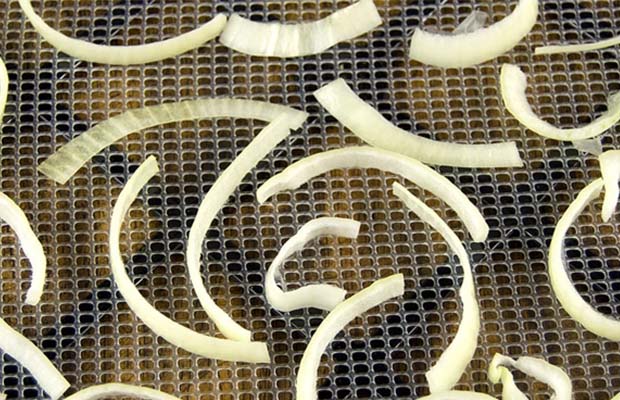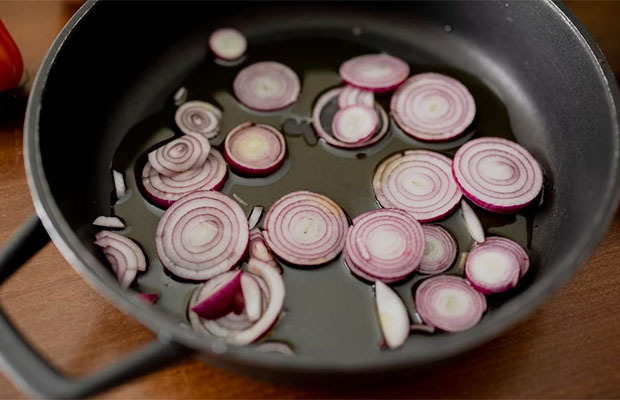Are the onions you have becoming mushy? Onions can be easily dried out so they keep longer in food storage. Make powdered onions, dried onion flakes, and dehydrated onion flakes from your onions.
In any household’s kitchen, onions are one of the most common food ingredients. Onions can be used in a variety of recipes both dried and freshly chopped due to their versatility. How to dehydrate onions?
Although dehydrated onions are not usually used for cooking, dehydrating them is a straightforward process. Dehydrated onions can be put to a variety of uses, including using for cooking and food storage.
Read on for a detailed explanation of the steps that will be taken.
Table of Contents
Steps for Making Dehydrated Onions
Red, white, and yellow onions can all be dried out. If you plan to cut by hand, you might want to protect your eyes and hands from the strong onion smell by donning gloves.
- Step 1: Prepare Your Onions
- Step 2: Spread the Onions Out on the Dehydrating Screens
- Step 3: Dry Your Onions
- Step 4: Package and Store Your Dried Onions
Let’s see each step in detail.
Step 1: Prepare Your Onions
Sliced onions should be uniform in size after being skinned, trimmed, and sliced. Onions are best cut in half, then each half is cut into pieces measuring 1/4 inch. To expedite the procedure, I occasionally use the slicing blade on my food processor.
As long as they are all roughly the same size, the onions can be any shape and still dry evenly. Whatever is most convenient can be used to cut the onions: rings, chunks, etc. Simply make sure the pieces are big enough to avoid falling through the dehydrator’s screens.
Tip: For homemade chicken stock, freeze the onion trimmings.
Step 2: Spread the Onions Out on the Dehydrating Screens
On your dehydrator tray, divide the onion segments into equal sections. Although the onion pieces can touch, avoid overlapping them to prevent uneven dehydration.

Step 3: Dry Your Onions
Depending on the size of your pieces and the moisture content of your onions, dehydrate at 125 °F for 3 to 9 hours, or until completely dry. The dehydrator can be turned off and restarted the following day. Observe the dehydrator’s instructions.
For uniform onion drying, rotate your trays. Onions that have been dried out should break easily when broken.
Step 4: Package and Store Your Dried Onions
After dehydrating the onions, allow them to cool before using a mallet or your hands to pound them into onion flakes, which you can then put in airtight glass containers.
The jars of dried onion flakes should be marked with a date and kept in a cool, dark location. In a few days, check the jars to make sure there isn’t any moisture building up on the glass.
The remainder of the dehydrated onions are kept in mason jars in my basement food storage area after I fill small jars for my spice cabinet. Although properly dehydrated onions won’t go bad, the flavor does get weaker over time.
Related Reading: How to Dehydrate Bananas?
Conditioning
Your dehydrated onions must be condition for safe storage. Don’t give up; it can be done.
Once the dry onions are in their container of storage, all that needs to be done is to shake them every day or so for about a week while checking the container for moisture.
- Put them in a cool, dark location for long-term storage if there are no indications of moisture.
- The onions must be put back in the dehydrator and dried for an extended period of time if there is any sign of moisture in the container. You will have to go through the conditioning procedure once more after they have been dried a second time.
Storing the Dehydrated Onions
Onions are simple to dehydrate. How to store dehydrated onions, though, is a tricky matter.
Increased shelf life is one of the main reasons to dry onions. They must be properly stored as a result. The dehydrated onions need to cool down before being stored.
They must be laid out in a loose bow after cooling, and they must be kept out of the sun for a few weeks. After that, gently shake them to see if any water drops have fallen into the container.
If there is no sign of moisture, the product can be placed in vacuum-sealed airbags to prevent product deterioration. However, the product must be stored in a cool, dry area that is dark and opaque if using airtight containers.
Ways to Use Dehydrated Onions
If you don’t have time to peel and chop onions, using dried onions as a substitute is the ideal kitchen shortcut. Here are some ways you can use dried onion flakes, dried minced onions, and onion powder in everyday cooking:
Add dried onions directly to foods: When soups and stews are simmering, add minced onions and dried onion flakes. With the liquid, they’ll reconstitute and flavor the mixture with onions.
Use onion powder in dry herb mixes: To add flavor, onion powder blends and dissolves easily. For shelf-stable mixes, such as homemade herb blends, taco seasoning, and rub mixtures, onion powder also mixes easily with dried herbs and spices.
Rehydrate dried onions: Minced onions that have been dehydrated can be reconstituted and used in foods that are both raw and cooked just like chopped onions. One part dried minced onion should be rehydrated by being soaked for 20 minutes in two parts warm water. then continue with your recipe.
Also Read:
FAQs
How Long Does Dehydrated Onions Last?
Dehydrated Onions will store for 10 to 15 years in a sealed #10 can (oxygen absorber included) under ideal storage conditions (cool, dry place). It typically lasts between six and twelve months after being opened.
How Healthy Are Dried Onions?
Fiber is abundant in the dried onions. These, like garlic, are a fantastic source of healthy sulfur compounds.
Read More: Dehydrating Food: Is It Good for You
What Quantity of Dried Onion Equals a Fresh Onion?
One tablespoon of minced, dried onion is equal to one small fresh onion.
What Can You Use Dehydrated Onions For?
They acquire a toastier, richer flavor than fresh onions during the drying process, making them the ideal choice for adding sweet onion flavor to any dish. Use them in dips, soups, stews, casseroles, egg dishes, hamburgers, salad dressings—anywhere you’d like to punch up the flavor.
Can You Rehydrate Dried Onions?
The dehydrated onions must be soaked in water to be rehydrated, so the answer is yes. After about 15 minutes, drain the water and leave the onion in it. Now, the onions will make for a flavorful substitution for fresh onions.

